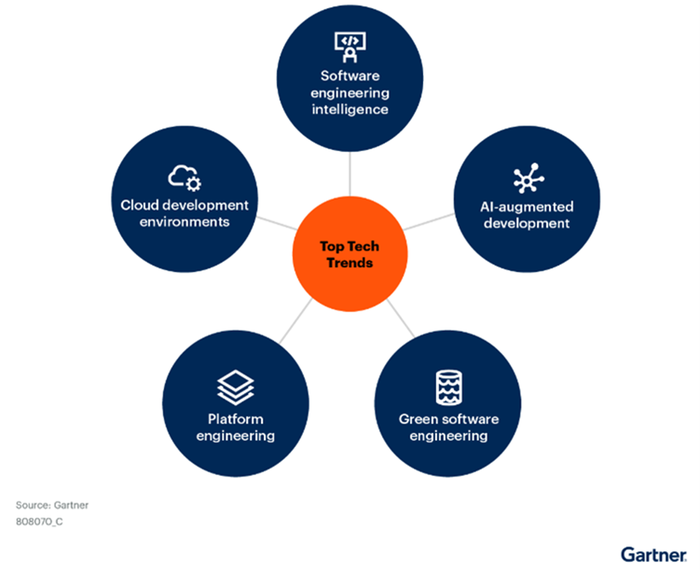Gartner Reveals 5 Trends That Will Make Software Engineering Faster, GreenerGartner Reveals 5 Trends That Will Make Software Engineering Faster, Greener
Gartner's top five strategic technology trends for software engineering in 2024 focus on enhancing productivity and sustainability.
May 27, 2024

Gartner has unveiled its list of the top five strategic technology trends in software engineering for 2024 and beyond — trends that are interconnected, aiming to improve productivity while fostering a greener environment.
According to a Gartner survey of 300 software engineering and application development team managers, meeting business objectives ranks among the top three performance goals for 65% of these leaders. Investing in disruptive technologies enables software engineering leaders to equip their teams to achieve objectives related to productivity, sustainability, and growth, Gartner stated.
"All of these five technologies are really connected to one another," Joachim Herschmann, VP analyst at Gartner, told ITPro Today. "Everything is driven by this desire for more productivity, for more efficiencies."

Here are Gartner's top five strategic technology trends for software engineering for 2024:
1. Software Engineering Intelligence
Gartner predicts that by 2027, 50% of software engineering organizations will be using software engineering intelligence platforms to measure and increase developer productivity, a significant increase from the 5% currently using such platforms.
Many other fields, such as finance and marketing, have dashboards that display important data for enhanced decision-making. Software engineering, however, has lacked such a dashboard. "Leaders would basically walk around and ask, 'So how are things going? How is our development going? How well are we doing with our coding?'" Herschmann said. "And so a lot of times, the answer was based on a gut feel and the experience of these people. But there was no hard data."
Software engineering intelligence platforms provide that hard data, he said, enabling software engineering leadersto, for instance,understand why a particular product may be struggling.
"What it all amounts to is basically a nice dashboard of information," he said. "And that's gold. And that's why we're anticipating this strong growth."
2. AI-Augmented Development
According to the Gartner survey, 58% of respondents said their organization is using or plans to use generative AI over the next 12 months to control or reduce costs. There are many advantages to implementing AI into the software development lifecycle, including enhancing productivity and efficiency and enabling faster code generation by providing manual code-writing help.
Herschmann said that while there is a worry that AI could eliminate coding jobs instead of just enhancing them, that worry is somewhat unfounded. "If anything, we believe there's going to be a need for more developers, which may at first seem a little counterintuitive, but the reality is that we're still in the early stages of all of this," he said.
"While generative AI is quite impressive in the beginning, if you dig a little bit deeper, you realize it's shinier than it really is," Herschmann said. So instead of replacing developers, AI will be more of a partner to them.
Herschmann compared genAI to a chainsaw. Before chainsaws, forest workers used handsaws to cut down trees. With the chainsaw, they have significantly improved their productivity, but there is a danger of getting seriously hurt if you don't know how to use one. "It's the same kind of thing here," he said. "[Generative AI is] incredibly accelerating, but if you don't know what you're doing, you're going to cut yourself in your knee."
That's why more developers may be needed: They have the experience to wield the device the right way.
3. Green Software Engineering
Gartner predicts that by 2027, 30% of large global enterprises will have adopted software sustainability requirements, up from less than 10% this year.
"It's good to see that there is more interest," Herschmann said. However, "at the end of the day, let's be honest — it's all about cost." That and public accountability. Organizations want to look good in their reports, he said.
It's not just about AI development, either, he said, although he added that there's a huge difference between the cost of using ChatGPT 3.5 versus 4.0. "That's a 20 times higher cost factor … because there's more compute power, which means it's less green."
The choice of programming language also contributes to sustainability. "There's astonishingly large differences between different programming languages — some are more resource-efficient than others," he said.
4. Platform Engineering
Gartner also predicts that by 2026, 80% of large software engineering organizations will establish platform engineering teams, up from 45% in 2022.
Coding is just a small part of a developer's role. There are a lot of other things they need to do, such as keep the environment running, configuration work, and so on. So it makes sense to have a platform engineering team to take some of this work off developers' plates so they can focus on building the product, according to Herschmann.
"Along with that though comes a potential scaling effect because you can then provide that same environment and the skills of that team to others as you scale up," he said. "And again, [there are green benefits] because you're not building the same thing over and over, but you provide a set of templates that others can reuse.

"These five traits are really connected because if you think about it that way, one thing falls into place with the other."
5.Cloud Development Environments
Cloud development environments provide remote, ready-to-use access to a cloud-hosted development environment with minimal effort for setup and configuration.
It used to take days and, in some cases, weeks to get new developers set up with the environments, the machines, and the approvals they needed. "The idea of these cloud development environments is that I can spin them up in a matter of 30 seconds," he said. "It's literally there. It's ready to run. I have access to everything I need, not just the development environment, but the documentation, the policies they're already built in. So I'm not wasting any time."
The reason cloud development environments are taking off is that finally, after quite a few years, the idea of software as a service (SaaS) and cloud-based environment has taken hold. "The majority of organizations have realized that it's so much easier to go down that route, and you can put all the right security mechanisms in place," Herschmann said.
To some extent, cloud development environments are linked to the other four trends, Herschmann said: "It's this idea that if I want to be more efficient, if I want to be more productive, I need to streamline things.
"The ideal picture would be to use these technologies to become faster, more efficient, and at the same time more carbon-friendly, greener," he said. "It's not going to a straight line to get there. It's more like a curved path. But, as long as the trend is going in the right direction, all things are good."
About the Author
You May Also Like








.jpg?width=700&auto=webp&quality=80&disable=upscale)
